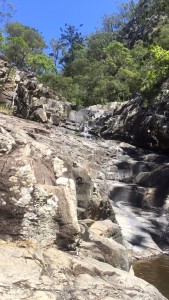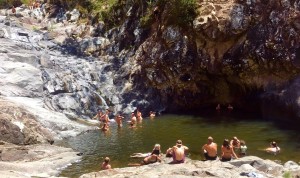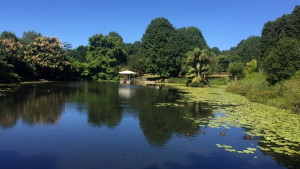This weekend I visited the Tamborine area Northwest of Gold Coast. Our first (stumbled upon) stop was at the very top of Mt. Tamborine, at a lookout point off the side of the road that showed a beautiful view of the land below. You could see far off to the mountains, giving an actual skyline view of the surrounding area.

View off Mt. Tamborine
Tamborine National Park
Our first planned stop was at the Tamborine National Park to spend some time swimming in the natural rock pools. I was expecting them to be enjoyable, but it turned out to be one of my favorite experiences so far! I also went to a rock pool last weekend, and these rock pools were much different but still amazing.
The rock pool I went to last week is an area carved out of rock right up against the ocean, near the border of Queensland and New South Wales. It had walls built up in a square, a flatter bottom, and was built right next to the ocean. Waves would crash on the side of the structure and even periodically spray past into the pool!
To get to these pools, you walk a little ways into the park, then follow a trail down the side of a small mountain canyon to where the rock waterfall starts. As you make your way down to the rocks you can start to see the pools, and a lot of people were there! The pool area starts with a waterfall at the very top, which flows over the rocks down about six or seven tiers, each with their own rock pool. The pools were various sizes and depths, and we spent time at the pool furthest down the canyon. This pool was not so crowded, the water was deeper, and there was even a small cliff jump and rope swing into the pool. It was a bit of rock climbing to get there, but such a great experience to carefully make my way into a pool that is literally natural fed with water, with rocks of various sized covered in algae lining the floor.
According to locals, during heavy rain the area has more water flowing through, so the waterfall is stronger and the pools larger, and when there is little rain the area dries out more. Luckily, when we visited there was just enough rain to have a smaller waterfall running and still nice pools. I wish I could have gotten a picture of the whole canyon, but due to the way it’s carved out, you could only see two or three tiers at a time. An aerial view would be beautiful to see. Unfortunately this must be a hard picture to get, because even Google couldn’t find one for me! However, in real life it looks like a scene that should be featured in National Geographic.

Top of rock pool canyon

Second tier pool, waterfall in the background

One of the rock pools
Mt. Tamborine Glow Worm Caves
For lunch we stopped at a local café, where I had one of the best veggie burgers of my life, and got to see the local lifestyle. Then we headed around the corner of the block where the Mt. Tamborine Glow Worm Caves were conveniently located! This has been an attraction I had wanted to visit since before I arrived in Australia, and since we happened to be so close by, we decided to check it out. Prior to the tour, we stopped by the beautiful pond they have on property and walked through a self guided frog house tour. The most unique part about this was that it was a relatively large pond, and while it was manmade, it was amazing that it stayed in such good condition despite the fact that it was placed directly on the very top of a mountain.

Pond on Glow Worm Cave property
While this property has a man made cave used for educational purposes, glow worms are a unique animal only existing in Australia and New Zealand. They are born, transform from egg to larva, pupa, then to an adult mosquito-like insect. Glow worms are the larvae, and the only stage in the insect’s life when they are able to glow. Adult flies only live for two days (females) or six days (male), and are not able to feed, so glow worms must consume enough nutrients during their larval stage to essentially get them through the rest of their life! In good conditions, larvae live for around one year.
Glow worms make silk threads that capture small insects for food, and get their name because of their special character trait of bioluminescence, or light produced by a living organism. A pigment called luciferin reacts with the enzyme luciferase and adenosine triphosphate (ATP) and the oxygen in the air to create the blue-green light that the glow worms emit. In nature, the lights can actually be so bright that they light up the cave enough to see where to walk. When standing in the cave, it looks similar to looking up into a night sky full of starts. Theoretically, the glow worms have adapted this way to make it look like a night sky, so potential prey will try to fly upwards and get stuck in the silk threads of the glow worms.
Another fun fact, our eyes are so trained to filter out extremely bright lights that when you look directly at the very tiny glow worms, it “disappears.” In comparison to the dark room, our eyes are unable to detect the light when looking directly at it, however you can still see them in peripheral vision. Unfortunately, we were not allowed to take photos inside the cave, but look below to see the best photo I could find online that looked like the cave we were in.

Example of a glow worm cave
(Source: Peter Clark, Bioluminescence, Pinterest)
This week is full of midterm exams, so it was nice to enjoy the weekend before lots of studying! Being able to spend time outside at such beautiful natural places has been one of my favorite parts of being in Australia. I am definitely planning on finding and checking out more places like this along the way!

